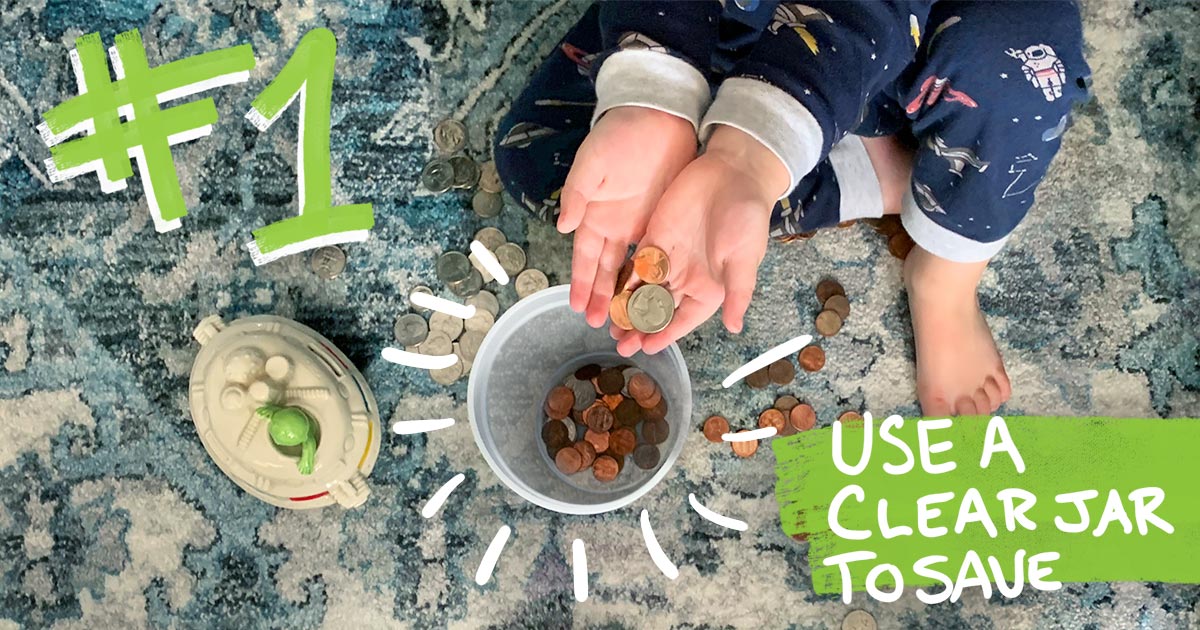15 Ways to Teach Kids About Money
8 Min Read | Jan 9, 2024

Y’all, I’m passionate about teaching kids about money. Not only is it part of my professional job, but it’s part of being a good mom (or being a good dad, for you guys reading). Here’s the thing: If you don’t teach your kids about money, somebody else will. And there’s a good chance that somebody else will have no idea what they’re talking about . . . or worse—they’ll steer your kids in the wrong direction. No, no, no.
Here’s how you can give your kids a head start and set them up to win with money at any age.
How to Teach Preschoolers and Kindergartners About Money
I know they’re only this little once, but preschoolers and kindergartners are old enough to count (and no doubt they’ve seen you spend money). My point being: It’s never too early to start teaching your kids about money, and this age is no exception.
1. Use a clear jar for their savings.
Who had one of those classic pink piggy banks growing up? It’s a great idea, but piggy banks don’t give kids a visual. When you use a clear jar, your kids can actually see the money growing. Yesterday, they had a dollar bill and five dimes. Today, they have a dollar bill, five dimes and a quarter. Talk through how when you save money, your money grows. And make a big deal about seeing their savings jar filling up.
2. Set an example with your own money habits.
Money habits in children are pretty much formed between the ages of 6 and 12.1 Little eyes are watching you. If you’re slapping down plastic every time you go out to dinner or the grocery store, your kids will notice. Or if you and your spouse argue about money all the time, they’ll see that too. Set a healthy example for them and they’ll be much more likely to follow it when they get older. After all, more is caught than taught.
3. Show them stuff costs money.
When you’re teaching kids about money, you’ve got to do more than just say, “Sorry, kids. That pack of cars costs $5.” They’ve got to experience how money works. Help them grab a few dollars out of their jar, take it with them to the store, and let them physically hand the money to the cashier. Experiencing the lesson in real time will have more impact than a five-minute lecture.
How to Teach Elementary Students and Middle Schoolers About Money
All right, when your kids hit the elementary or tween years, that’s when you can get really hands-on with teaching them about money. By this age, kids have a better understanding of how money works and what it’s used for: spending, saving and giving.
4. Show them how opportunity cost works.
Opportunity cost is another way of saying, “If you buy this video game, you won’t have the money to buy that pair of shoes.” At this age, your kids should be able to weigh decisions and understand the possible outcomes. Help them understand just how far their dollars will stretch by comparing the cost of one item they want to another.
5. Give commissions, not allowances.
I’m all for generosity, but don’t just give your kids money because you can. Pay them commissions based on chores they do around the house, like taking out the trash, cleaning their room, or mowing the grass. I talk a lot about this in the book I wrote with my dad, Smart Money Smart Kids. This concept helps your kids understand that money is earned—it’s not just handed out willy-nilly.
6. Avoid impulse buys.
“Mom, look at this cute dress! It’s perfect, and I love it! Can we buy it please? Pretty please?” Sound familiar? This age group really knows how to capitalize on the impulse buy—especially when it’s on someone else’s dime.
Use the best tools to teach your kids about money.
Instead of caving in, tell your child they can use their hard-earned commission to pay for it. I also recommend having your kid wait at least a day before they buy anything that costs more than $15. It will likely still be there tomorrow, and they’ll be able to make that decision with a level head. (And it’s possible they’ll forget about it entirely . . . in which case, that’s $15 saved.)
7. Stress the importance of giving.
Once your kids start making a little money, be sure you teach them about giving and being generous. They can pick a church, charity or even someone they know who needs a little help. Eventually, they’ll see how giving doesn’t just help the other person—it feels good to you too.
How to Teach Teenagers About Money
No need to fear the teen years, parents. At this point, your kids should have a strong understanding of the money basics. Now it’s time to teach them more responsibility and how to use their money with the future in mind.
8. Teach them contentment.
Your teen probably spends a lot of their time staring at a screen, scrolling through social media. Every time they’re online, they see the highlight reels of their friends, family and total strangers. It’s the quickest way to bring on the comparison trap. You might hear them say things like:
“Dad, Mark’s parents bought him a brand-new car. How come I have to drive this 2007 Honda?”
“Mom, this girl at school got to spend $10,000 on her Sweet 16 party. I want to do that too.”
“Brittney’s going to the beach for spring break. Why can’t we?”
Contentment starts in the heart. Let your teen know their older Subaru is still running well enough to get them from point A to point B. And you can still throw a memorable milestone birthday party or go on a weekend getaway without using a chunk of your retirement savings to fund it.
9. Give them the responsibility of a bank account.
By the time they’re a teenager, you should be able to set your kids up with a simple bank account. This takes money management to the next level and (hopefully) prepares them for managing a much bigger account when they get older.
10. Get them saving for college.
There’s no time like the present to have your teen start saving for college. Do they plan on working a summer job? Perfect. Take a portion of their paycheck to toss in a college savings account. Your teen will feel like they have skin in the game as they contribute toward their education.
11. Teach them to steer clear of student loans.
Before your teen ever applies to college, you need to sit down and have the talk—the “how are we going to pay for college?” talk. Let your teen know student loans aren’t an option to fund their education. Talk through all the alternatives out there, like going to community college, going to an in-state university, working part-time while in school, and applying for scholarships now.
12. Teach them the danger of credit cards.
As soon as your kid turns 18 (cue the birthday cake!), they’ll get hounded by credit card offers—especially once they’re in college. Seriously, look out. If you haven’t taught them why debt is a bad idea, they’ll become yet another credit card victim. Remember, it’s up to you to decide when to teach them how to be smart with money. The sooner the better.
13. Get them on a simple budget.
Since your teen is glued to their phone anyway, get them started with our simple budgeting app, EveryDollar. Now is the time to get your teen in the habit of budgeting their income—no matter how much they make. They should understand why it’s so important to make a plan for their money while they’re still under your roof.
Save more. Spend better. Budget confidently.
Get EveryDollar: the free app that makes creating—and keeping—a budget simple. (Yes, please.)
14. Introduce them to the magic of compound growth.
I know what you’re thinking . . . You can barely get your teen to do their own laundry—how in the world are they supposed to become investment savvy? Listen, the earlier they get started investing, the better. Compound growth is a magical thing. Introduce your teen to it at an early age, and they’ll be way ahead of the game by the time they enter the professional world.
15. Help them figure out how to make money.
When you think about it, teenagers have plenty of free time—fall break, summer break, winter break, spring break. If they want to make some money (and what teen doesn’t?), help them find a job. Better yet, help them become an entrepreneur. These days, it’s easier than ever for your teen to start up their own business and turn a profit.
You Can Change Your Family Tree
Teaching your children about money at any age and stage of the game will take time and intention on your part. And it won’t always be easy. But if you want your children to manage their money responsibly, taking the time now will be worth it. Check out the Financial Peace Kids toolkit for an easy way to teach kids all about money. It covers four basic concepts including working, spending, saving and giving. See what it’s all about today!
What Are My Next Steps?
- Set an example with your own money habits. Remember, more is caught than taught!
- Give commissions, not allowances. This will help kids learn how to earn.
- Teach your kids contentment while they learn how to give, save and spend.



